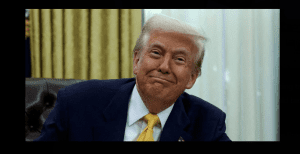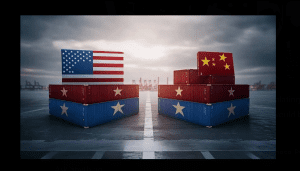Beijing/Washington, April 8, 2025 — In a dramatic escalation of global trade tensions, current U.S. President Donald Trump has issued a bold tariff threat, announcing plans to impose an additional 50% tariff on Chinese goods—a move that triggered an immediate and fierce response from Beijing. In a strongly worded statement, China condemned the proposed measure as “blackmail” and a “mistake on top of a mistake,” vowing to “fight to the end” if Washington follows through on the tariff escalation.
The latest development comes amid growing strains in U.S.-China relations, as President Trump doubles down on his protectionist economic agenda in a bid to secure American industrial dominance and curb what his administration describes as systemic trade imbalances. Trump’s renewed tariff push—on top of already existing high duties—appears designed to pressure Beijing into altering its trade practices, intellectual property regulations, and export-led economic strategies.
However, Beijing views this escalating tariff threat as a form of economic intimidation, and a serious violation of international trade norms. China’s Ministry of Commerce warned of swift and firm retaliation, asserting that the country “will never accept blackmail” and is prepared to defend its core interests with equivalent or even broader countermeasures.
With both economic powerhouses hardening their positions, fears are mounting that this latest move could reignite a full-scale trade war, destabilize global markets, and send economic shockwaves across supply chains and emerging economies around the world.
Also Read: Trump Doubles Down on Tariffs, Citing Low Oil Prices and Tamed Inflation
China’s Strong Reaction
In a sharply worded official statement, China’s Ministry of Commerce denounced the U.S. administration’s latest tariff proposal, asserting that the country “will never accept blackmail” and “reserves the right to take all necessary countermeasures to protect national interests.” The Ministry stressed that such unilateral trade measures constitute a serious breach of World Trade Organization (WTO) rules and accused the U.S. of deliberately destabilizing the global trade system for domestic political gain.
“The United States is making a mistake on top of a mistake,” said Ministry spokesperson He Yadong during a press briefing in Beijing. “This is not negotiation. This is coercion—and China will not back down under pressure.”
Chinese officials also emphasized that the country has ample tools at its disposal to retaliate economically. These include higher tariffs on American agricultural and energy exports, sanctions on key U.S. technology firms operating in China, and possible restrictions on exports of rare earth elements—materials critical to global electronics and defense industries. Experts suggest such moves could significantly disrupt American manufacturing and consumer markets, particularly in the high-tech and automotive sectors.
Moreover, China’s response was echoed by several state-run media outlets, including The Global Times, which accused the U.S. of weaponizing trade for political purposes and warned that “any attempt to suppress China through tariff bullying will ultimately backfire.”
Retaliation and Global Implications
If the proposed 50% tariff hike is implemented, the total U.S. tariffs on Chinese imports could surpass 100%—marking the most aggressive and far-reaching trade measure in the history of U.S.-China economic relations. Experts suggest this move would affect hundreds of billions of dollars in goods, ranging from electronics and machinery to clothing, toys, and intermediate components crucial to American manufacturing.


-
Suspension of large-scale agricultural purchases, particularly soybeans, corn, and pork—sectors heavily reliant on exports to China and politically significant in key U.S. farming states.
-
Implementation of tit-for-tat tariffs on major American exports including automobiles, aircraft, and energy products such as liquefied natural gas (LNG).
-
Strategic restrictions on exports of critical minerals and rare earth elements, which are essential for the production of semiconductors, batteries, renewable energy components, and defense technologies. China currently supplies over 60% of global rare earths, giving it significant leverage in the global tech supply chain.
The ripple effect of these tensions is already being felt. Stock indices across Asia and Europe registered sharp declines following the announcement, with the Nikkei 225 dropping over 2.3%, and Germany’s DAX falling by nearly 1.8% amid investor fears of prolonged trade disruptions.
Economists are warning that a full-scale tariff war could deal a serious blow to both economies. According to projections by Bloomberg Economics and Oxford Economics, a sustained trade conflict could reduce China’s GDP growth by up to 2 percentage points and raise U.S. consumer prices by 1.5% to 2.2%, exacerbating inflationary pressures and possibly triggering additional interest rate hikes by the Federal Reserve.
Meanwhile, supply chain disruptions could push global companies to reconsider their reliance on either nation, accelerating a trend toward “de-risking” and diversification of manufacturing hubs to countries like Vietnam, India, and Mexico—though such shifts would take years to fully materialize.
Trade War Redux?
While the Biden administration had sought to cool down trade tensions and reframe U.S.-China relations through diplomatic engagement and multilateral cooperation, President Trump’s renewed tariff threats mark a stark return to the combative, unilateral approach that defined his first term. This aggressive pivot underscores Trump’s longstanding belief that tariffs are a powerful tool for economic leverage, and it signals a broader shift back toward economic nationalism just as the global economy begins to stabilize post-pandemic.
 Analysts warn that Trump’s re-entry into the trade discourse—this time from a position of renewed executive power—could reshape global supply chains, reintroduce economic uncertainty, and significantly polarize U.S.-China relations. His rhetoric of “economic self-reliance” and “decoupling” from China resonates with certain domestic constituencies, but risks alienating allies and international trade partners who favor stability and rules-based commerce.
Analysts warn that Trump’s re-entry into the trade discourse—this time from a position of renewed executive power—could reshape global supply chains, reintroduce economic uncertainty, and significantly polarize U.S.-China relations. His rhetoric of “economic self-reliance” and “decoupling” from China resonates with certain domestic constituencies, but risks alienating allies and international trade partners who favor stability and rules-based commerce.
The timing of these developments is particularly sensitive. Many multinational corporations had just begun recalibrating operations to adapt to the Biden-era approach of “competition without confrontation.” Trump’s aggressive trade posture threatens to disrupt these recalibrations, potentially accelerating a global shift toward regionalized supply chains and investment realignment in Southeast Asia and Latin America.
International observers, including the World Trade Organization (WTO) and International Monetary Fund (IMF), are urging both Washington and Beijing to resume structured dialogue. “This kind of brinkmanship is dangerous,” warned a senior WTO analyst in Geneva. “It risks not only bilateral damage but a contagion effect across emerging markets, many of which are still grappling with post-pandemic recovery and persistent inflation.”
Global financial institutions are also concerned about the strain this renewed tension could place on international lending, investment flows, and central bank policies. With emerging economies already facing capital outflows, rising debt servicing costs, and inflation volatility, a U.S.-China trade standoff could tip vulnerable nations into recessionary territory, especially those heavily reliant on export-led growth.
Conclusion
President Trump’s sharp turn toward increased tariffs marks a pivotal moment in the ongoing U.S.-China trade saga—one that could shape global economic dynamics for years to come. Framing the tariff threat as a necessary corrective measure, the Trump administration maintains that tougher trade policies are essential to reclaiming U.S. industrial strength, curbing China’s economic leverage, and addressing long-standing trade deficits. However, the Chinese government views the move as a hostile act of economic bullying, and a direct challenge to its sovereignty and global market status.
China has vowed to retaliate with “strong and resolute measures,” which may include raising tariffs on key U.S. imports, halting agricultural purchases, and limiting exports of critical minerals vital to American tech manufacturing. Global financial markets, already rattled by inflationary pressures and interest rate fluctuations, have responded with sharp declines, reflecting growing uncertainty over the stability of international trade routes and diplomatic channels.
Analysts warn that if this tariff war spirals further, it could dent consumer confidence, increase production costs, and fracture long-standing supply chains, especially in technology, automotive, and agriculture sectors. Meanwhile, businesses and consumers in both nations brace for costlier goods and a potentially prolonged standoff.
As the world’s two largest economies inch closer to another full-blown trade war, international organizations such as the WTO and IMF are urging both parties to de-escalate and return to the negotiating table. Whether that happens remains unclear.
🔗 For official details on China’s response to the U.S. tariff escalation, refer to the statement published by China’s Ministry of Commerce via the Associated Press:
👉 China hits back at Trump’s additional tariff threat – AP News

